Research Progress, Trends, and Current State of Development on PEMFC-New Insights from a Bibliometric Analysis and Characteristics of Two Decades of Research Output
Abstract
1. Introduction
2. Current Status of Hydrogen Economy and Trade Globally
3. Hydrogen Fuel Cell
3.1. Proton Exchange Membrane (PEMFC)
Operating Principle of the PEMFC
- Reaction subsystem.
- Thermal subsystem.
- Water management subsystem.
- Power electronics subsystem.
3.2. Cost and Cost Projections of PEMFC
4. Methodology for the Bibliometric Analyses
4.1. Bibliometric Analysis Framework
4.2. Data Sources and Collection Methods
5. Results
5.1. Global Overview of PEMFC Research in the 21st Century
5.2. Research Characteristics, Hotspots, and Frontiers
- #0 Oxygen reduction reaction: The oxygen reduction reaction defines the overall performance of the fuel cell, as it determines the efficacy of the type of catalyst being used to speed up the electrochemical reactions. In the last decades, different types of catalysts have been explored, largely depending on their cost and how they improve cell performance. Platinum, nanomaterials, etc., are a few that have been explored in recent times.
- #1 Proton exchange membrane fuel cell: PEMFCs, due to their low operating range, makes them suitable for diverse applications, as explained in previous sessions. The recent spikes globally in power harnessed from the grid have made the research community turn to PEMFCs as suitable replacements for conventional power needed for the automotive industry. It explains the justification for the high number of detailed technical research activities being championed in this field. The other key justification is the fact that PEMFC could be coupled to other energy generation sources for stationary and portable applications. It further explains the recent funding programmes being championed across the globe to further accelerate its commercialization in other global economies. The fact that it is environmentally friendly also means industries will no longer have to struggle to meet emission standards and protocols or pay exorbitant prices for the decarbonization of their business.
- #2 Composite membrane: Bottlenecks that often come to mind when PEMFC is mentioned in the fuel cell industry is its range of operation. This is because Nafion, being one of the most often used membranes, tends to go through performance challenges beyond 80 °C. Since most industries work with temperatures beyond 80 °C, the search for alternatives to Nafion membranes led to the evolution of composite materials, which are usually made up of Nafion membranes and PTFE fibrous substrates, which became the primary research direction for the fuel cell research community.
- #3 Automotive industry: To meet emission standards, most automotive companies decided to change their fossil-based powertrains to electric powertrains by replacing the gearbox with an electric motor. This decision received global attention until recently, when questions about the sources of electricity needed for charging the batteries coupled with the duration for charging these batteries became an issue of concern for both the end user and policymakers. This clarion call led to further investigation into replacing the power-generating medium in existing electric vehicles with fuel cells and onboard hydrogen storage units. It, however, led to the accelerated development of fuel cells, particularly for the best interest of the automotive industry. Several research activities aimed at reducing the weight of the cell to meet the standard weight of conventional vehicles have equally been explored but are predominantly geared towards improving the overall performance of the powertrain.
- #4 Oxygen reduction reaction measurement: The catalyst is what speeds up chemical reactions within the cell, hence its optimization will have a direct impact on the evolution of electrons from the cell, which will reduce the cost of running the cell since hydrogen gas is expensive. This has become a focal research point, largely because there are other materials that could improve the cell performance but are expensive and usually have a detrimental effect on the parameters of the PEMFC.
- #5 Anion exchange membrane fuel cell: These areas of research are geared toward improving the membrane of fuel cells where anion exchange membranes are used in the separation of the anode and cathode electrodes. This is critical because the membrane serves as a barrier in ensuring the reactants do not mix during the operation of the cell. An effect separation will imply that all electrons being released will be captured, hence reducing the losses within the cell.
- #6 Fuel cell technologies: There are several types of fuel cell technologies, and each of them has a direct route to the industry or the automotive sector; these technologies are now being explored to augment and reduce carbon emissions from some of these sectors. In some parts of the world, these technologies have equally served as a medium of livelihood to support families as some companies train and teach indigenes on the functionality of the cell and its operation.
- #7 Performance enhancement: To further accelerate the commercialization of PEMFC, its performance should be improved in terms of the voltage that can be harnessed from the cell, as well as a reduction in the weight of the cell. This explains the efforts being made in designing novel flow plates, membranes, catalysts, etc., to attain the best cell performance.
5.3. Discussion
6. Conclusions
- First, the research field is growing at an annual average growth rate of 19.35%, with the first article within the study period published in 2000, which talks about a methanol reformer concept, including a reformer, a catalytic burner, a gas cleaning unit, a PEMFC, and an electric motor for use in fuel-cell-powered passenger cars.
- China and the US have been the major contributors in the field, with a combined 8915 documents. China-based authors, institutions, and funding agencies have been very dominant, which could be attributed partly to the country’s plan to reach a carbon peak by 2030 and carbon neutrality by 2060.
- The International Journal of Hydrogen Energy has been the main knowledge disseminator on a journal level, publishing 14% of the total articles available in the 21 years of the study period.
- Based on the research hotspots identified, the focus of the field in the last two decades has been to enhance the performance, efficiency, and durability of the PEMFC. Keywords such as ORR, electrocatalysis, gas diffusion layer, bipolar plate, water management, and polybenzimidazole have received the most attention from researchers in the field.
- We call on scientists to actively continue developing novel and functional materials with high catalytic activity for improving the overall performance of the fuel cell. The PEMFC stack could be researched in more detail on how to decrease its cost in order to drive the fuel cell’s penetration rate.
Author Contributions
Funding
Institutional Review Board Statement
Informed Consent Statement
Data Availability Statement
Conflicts of Interest
Appendix A
| Rank | Paper DOI | Citations |
|---|---|---|
| 1 | 10.1126/science.1135941 | 3470 |
| 2 | 10.1126/science.1170051 | 2616 |
| 3 | 10.1126/science.1170377 | 2587 |
| 4 | 10.1038/nchem.367 | 2292 |
| 5 | 10.1021/ja403440e | 2270 |
| 6 | 10.1149/1.2050347 | 1290 |
| 7 | 10.1149/1.3483106 | 1125 |
| 8 | 10.1038/nmat2074 | 1122 |
| 9 | 10.1038/ncomms1427 | 1066 |
| 10 | 10.1002/anie.201204958 | 1045 |

References
- Kianfard, H.; Khalilarya, S.; Jafarmadar, S. Exergy and Exergoeconomic Evaluation of Hydrogen and Distilled Water Production via Combination of PEM Electrolyzer, RO Desalination Unit and Geothermal Driven Dual Fluid ORC. Energy Convers. Manag. 2018, 177, 339–349. [Google Scholar] [CrossRef]
- Afrane, S.; Ampah, J.D.; Agyekum, E.B.; Amoh, P.O.; Yusuf, A.A.; Fattah, I.M.R.; Agbozo, E.; Elgamli, E.; Shouran, M.; Mao, G.; et al. Integrated AHP-TOPSIS under a Fuzzy Environment for the Selection of Waste-To-Energy Technologies in Ghana: A Performance Analysis and Socio-Enviro-Economic Feasibility Study. Int. J. Environ. Res. Public Health 2022, 19, 8428. [Google Scholar] [CrossRef] [PubMed]
- Abu-Rumman, G.; Khdair, A.I.; Khdair, S.I. Current Status and Future Investment Potential in Renewable Energy in Jordan: An Overview. Heliyon 2020, 6, e03346. [Google Scholar] [CrossRef] [PubMed]
- Escobar-Yonoff, R.; Maestre-Cambronel, D.; Charry, S.; Rincón-Montenegro, A.; Portnoy, I. Performance Assessment and Economic Perspectives of Integrated PEM Fuel Cell and PEM Electrolyzer for Electric Power Generation. Heliyon 2021, 7, e06506. [Google Scholar] [CrossRef] [PubMed]
- Zhao, Y.; Ramzan, M.; Adebayo, T.S.; Oladipupo, S.D.; Adeshola, I.; Agyekum, E.B. Role of Renewable Energy Consumption and Technological Innovation to Achieve Carbon Neutrality in Spain: Fresh Insights From Wavelet Coherence and Spectral Causality Approaches. Front. Environ. Sci. 2021, 9, 769067. [Google Scholar] [CrossRef]
- Abdelhamid, M.; Kamel, S.; Ahmed, E.M.; Agyekum, E.B. An Adaptive Protection Scheme Based on a Modified Heap-Based Optimizer for Distance and Directional Overcurrent Relays Coordination in Distribution Systems. Mathematics 2022, 10, 419. [Google Scholar] [CrossRef]
- Praveenkumar, S.; Agyekum, E.B.; Ampah, J.D.; Afrane, S.; Velkin, V.I.; Mehmood, U.; Awosusi, A.A. Techno-Economic Optimization of PV System for Hydrogen Production and Electric Vehicle Charging Stations under Five Different Climatic Conditions in India. Int. J. Hydrogen Energy 2022, 47, 38087–38105. [Google Scholar] [CrossRef]
- Sun, C.; Negro, E.; Vezzù, K.; Pagot, G.; Cavinato, G.; Nale, A.; Herve Bang, Y.; Di Noto, V. Hybrid Inorganic-Organic Proton-Conducting Membranes Based on SPEEK Doped with WO3 Nanoparticles for Application in Vanadium Redox Flow Batteries. Electrochim. Acta 2019, 309, 311–325. [Google Scholar] [CrossRef]
- Ursúa, A.; Sanchis, P. Static–Dynamic Modelling of the Electrical Behaviour of a Commercial Advanced Alkaline Water Electrolyser. Int. J. Hydrogen Energy 2012, 37, 18598–18614. [Google Scholar] [CrossRef]
- Ampah, J.D.; Jin, C.; Rizwanul Fattah, I.M.; Appiah-Otoo, I.; Afrane, S.; Geng, Z.; Yusuf, A.A.; Li, T.; Mahlia, T.M.I.; Liu, H. Investigating the Evolutionary Trends and Key Enablers of Hydrogen Production Technologies: A Patent-Life Cycle and Econometric Analysis. Int. J. Hydrogen Energy 2022, S0360319922033912. [Google Scholar] [CrossRef]
- Smith, A.M.; Ross, A.B. Production of Bio-Coal, Bio-Methane and Fertilizer from Seaweed via Hydrothermal Carbonisation. Algal Res. 2016, 16, 1–11. [Google Scholar] [CrossRef]
- Ampah, J.D.; Afrane, S.; Agyekum, E.B.; Adun, H.; Yusuf, A.A.; Bamisile, O. Electric Vehicles Development in Sub-Saharan Africa: Performance Assessment of a Standalone Renewable Energy Systems for Hydrogen Refuelling and Electricity Charging Stations (HRECS). J. Clean. Prod. 2022, 376, 134238. [Google Scholar]
- Napole, C.; Derbeli, M.; Barambones, O. A Global Integral Terminal Sliding Mode Control Based on a Novel Reaching Law for a Proton Exchange Membrane Fuel Cell System. Appl. Energy 2021, 301, 117473. [Google Scholar] [CrossRef]
- Zakaria, Z.; Kamarudin, S.K.; Timmiati, S.N. Membranes for Direct Ethanol Fuel Cells: An Overview. Appl. Energy 2016, 163, 334–342. [Google Scholar] [CrossRef]
- Ho, J.C.; Saw, E.-C.; Lu, L.Y.Y.; Liu, J.S. Technological Barriers and Research Trends in Fuel Cell Technologies: A Citation Network Analysis. Technol. Forecast. Soc. Change 2014, 82, 66–79. [Google Scholar] [CrossRef]
- Dang, D.K.; Zhou, B. Liquid Water Transport in PEMFC Cathode with Symmetrical Biomimetic Flow Field Design Based on Murray’s Law. Int. J. Hydrogen Energy 2021, 46, 21059–21074. [Google Scholar] [CrossRef]
- Wilberforce, T.; Ijaodola, O.; Ogungbemi, E.; Hassan, Z.E.; Thompson, J.; Olabi, A.G. Effect of Bipolar Plate Materials on Performance of Fuel Cells. In Reference Module in Materials Science and Materials Engineering; Elsevier: Amsterdam, The Netherlands, 2018; ISBN 978-0-12-803581-8. [Google Scholar]
- Pamplona Solis, B.; Cruz Argüello, J.C.; Gómez Barba, L.; Gurrola, M.P.; Zarhri, Z.; TrejoArroyo, D.L. Bibliometric Analysis of the Mass Transport in a Gas Diffusion Layer in PEM Fuel Cells. Sustainability 2019, 11, 6682. [Google Scholar] [CrossRef]
- Agyekum, E.B.; Nutakor, C.; Agwa, A.M.; Kamel, S. A Critical Review of Renewable Hydrogen Production Methods: Factors Affecting Their Scale-Up and Its Role in Future Energy Generation. Membranes 2022, 12, 173. [Google Scholar] [CrossRef]
- Ramachandran, K.; Vinothkannan, M.; Kim, A.R.; Ramakrishnan, S.; Yoo, D.J. Ultrafine Bimetallic Alloy Supported on Nitrogen Doped Reduced Graphene Oxide toward Liquid-Fuel Oxidation: Profile of Improved Performance and Extended Durability. Int. J. Hydrogen Energy 2019, 44, 21769–21780. [Google Scholar] [CrossRef]
- Sagaria, S.; Costa Neto, R.; Baptista, P. Assessing the Performance of Vehicles Powered by Battery, Fuel Cell and Ultra-Capacitor: Application to Light-Duty Vehicles and Buses. Energy Convers. Manag. 2021, 229, 113767. [Google Scholar] [CrossRef]
- Pourrahmani, H.; Yavarinasab, A.; Siavashi, M.; Matian, M.; Van herle, J. Progress in the Proton Exchange Membrane Fuel Cells (PEMFCs) Water/Thermal Management: From Theory to the Current Challenges and Real-Time Fault Diagnosis Methods. Energy Rev. 2022, 1, 100002. [Google Scholar] [CrossRef]
- Pourrahmani, H.; Van herle, J. Evaluation Criterion of Proton Exchange Membrane (ECPEM) Fuel Cells Considering Inserted Porous Media inside the Gas Flow Channel. Appl. Therm. Eng. 2022, 203, 117952. [Google Scholar] [CrossRef]
- Olabi, A.G.; Wilberforce, T.; Sayed, E.T.; Elsaid, K.; Abdelkareem, M.A. Prospects of Fuel Cell Combined Heat and Power Systems. Energies 2020, 13, 4104. [Google Scholar] [CrossRef]
- Wilberforce, T.; Olabi, A.G.; Muhammad, I.; Alaswad, A.; Sayed, E.T.; Abo-Khalil, A.G.; Maghrabie, H.M.; Elsaid, K.; Abdelkareem, M.A. Recovery of Waste Heat from Proton Exchange Membrane Fuel Cells—A Review. Int. J. Hydrogen Energy 2022. [Google Scholar] [CrossRef]
- Chen, X.; Gong, G.; Wan, Z.; Luo, L.; Wan, J. Performance Analysis of 5 KW PEMFC-Based Residential Micro-CCHP with Absorption Chiller. Int. J. Hydrogen Energy 2015, 40, 10647–10657. [Google Scholar] [CrossRef]
- Olabi, A.G.; Wilberforce, T.; Abdelkareem, M.A. Fuel Cell Application in the Automotive Industry and Future Perspective. Energy 2021, 214, 118955. [Google Scholar] [CrossRef]
- Wang, Y.; Chen, K.S.; Mishler, J.; Cho, S.C.; Adroher, X.C. A Review of Polymer Electrolyte Membrane Fuel Cells: Technology, Applications, and Needs on Fundamental Research. Appl. Energy 2011, 88, 981–1007. [Google Scholar] [CrossRef]
- Dafalla, A.M.; Jiang, F. Stresses and Their Impacts on Proton Exchange Membrane Fuel Cells: A Review. Int. J. Hydrogen Energy 2018, 43, 2327–2348. [Google Scholar] [CrossRef]
- Ryu, S.K.; Vinothkannan, M.; Kim, A.R.; Yoo, D.J. Effect of Type and Stoichiometry of Fuels on Performance of Polybenzimidazole-Based Proton Exchange Membrane Fuel Cells Operating at the Temperature Range of 120–160 °C. Energy 2022, 238, 121791. [Google Scholar] [CrossRef]
- Vinothkannan, M.; Kim, A.R.; Yoo, D.J. Potential Carbon Nanomaterials as Additives for State-of-the-Art Nafion Electrolyte in Proton-Exchange Membrane Fuel Cells: A Concise Review. RSC Adv. 2021, 11, 18351–18370. [Google Scholar] [CrossRef]
- Sankar, K.; Aguan, K.; Jana, A.K. A Proton Exchange Membrane Fuel Cell with an Airflow Cooling System: Dynamics, Validation and Nonlinear Control. Energy Convers. Manag. 2019, 183, 230–240. [Google Scholar] [CrossRef]
- Ostroverkh, A.; Johánek, V.; Dubau, M.; Kúš, P.; Khalakhan, I.; Šmíd, B.; Fiala, R.; Václavů, M.; Ostroverkh, Y.; Matolín, V. Optimization of Ionomer-Free Ultra-Low Loading Pt Catalyst for Anode/Cathode of PEMFC via Magnetron Sputtering. Int. J. Hydrogen Energy 2019, 44, 19344–19356. [Google Scholar] [CrossRef]
- Ionescu, V. Simulating the Effect of Gas Channel Geometry on PEM Fuel Cell Performance by Finite Element Method. Procedia Technol. 2016, 22, 713–719. [Google Scholar] [CrossRef]
- Valério Neto, E.S.; Almeida, C.V.S.; Colmati, F.; Ciapina, E.G.; Salazar-Banda, G.R.; Eguiluz, K.I.B. Pt Nanowires as Electrocatalysts for Proton-Exchange Membrane Fuel Cells Applications: A Review. J. Electroanal. Chem. 2022, 910, 116185. [Google Scholar] [CrossRef]
- Soares, L.A.; Morais, C.; Napporn, T.W.; Kokoh, K.B.; Olivi, P. Beneficial Effects of Rhodium and Tin Oxide on Carbon Supported Platinum Catalysts for Ethanol Electrooxidation. J. Power Sour. 2016, 315, 47–55. [Google Scholar] [CrossRef]
- Saha, M.S.; Li, R.; Cai, M.; Sun, X. Nanowire-Based Three-Dimensional Hierarchical Core/Shell Heterostructured Electrodes for High Performance Proton Exchange Membrane Fuel Cells. J. Power Sour. 2008, 185, 1079–1085. [Google Scholar] [CrossRef]
- Salazar-Banda, G.R.; Eguiluz, K.I.B.; Pupo, M.M.S.; Suffredini, H.B.; Calegaro, M.L.; Avaca, L.A. The Influence of Different Co-Catalysts in Pt-Based Ternary and Quaternary Electro-Catalysts on the Electro-Oxidation of Methanol and Ethanol in Acid Media. J. Electroanal. Chem. 2012, 668, 13–25. [Google Scholar] [CrossRef]
- Shabani, B.; Hafttananian, M.; Khamani, S.; Ramiar, A.; Ranjbar, A.A. Poisoning of Proton Exchange Membrane Fuel Cells by Contaminants and Impurities: Review of Mechanisms, Effects, and Mitigation Strategies. J. Power Sour. 2019, 427, 21–48. [Google Scholar] [CrossRef]
- Song, W.J.; Chen, H.; Guo, H.; Ye, F.; Li, J.R. Research Progress of Proton Exchange Membrane Fuel Cells Utilizing in High Altitude Environments. Int. J. Hydrogen Energy 2022, 47, 24945–24962. [Google Scholar] [CrossRef]
- Yang, B.; Li, J.; Li, Y.; Guo, Z.; Zeng, K.; Shu, H.; Cao, P.; Ren, Y. A Critical Survey of Proton Exchange Membrane Fuel Cell System Control: Summaries, Advances, and Perspectives. Int. J. Hydrogen Energy 2022, 47, 9986–10020. [Google Scholar] [CrossRef]
- Yue, M.; Lambert, H.; Pahon, E.; Roche, R.; Jemei, S.; Hissel, D. Hydrogen Energy Systems: A Critical Review of Technologies, Applications, Trends and Challenges. Renew. Sustain. Energy Rev. 2021, 146, 111180. [Google Scholar] [CrossRef]
- Wang, C.; Wang, S.; Peng, L.; Zhang, J.; Shao, Z.; Huang, J.; Sun, C.; Ouyang, M.; He, X. Recent Progress on the Key Materials and Components for Proton Exchange Membrane Fuel Cells in Vehicle Applications. Energies 2016, 9, 603. [Google Scholar] [CrossRef]
- Alvarez-Meaza, I.; Zarrabeitia-Bilbao, E.; Rio-Belver, R.M.; Garechana-Anacabe, G. Fuel-Cell Electric Vehicles: Plotting a Scientific and Technological Knowledge Map. Sustainability 2020, 12, 2334. [Google Scholar] [CrossRef]
- Garousi, V. A Bibliometric Analysis of the Turkish Software Engineering Research Community. Scientometrics 2015, 105, 23–49. [Google Scholar] [CrossRef]
- Filser, L.D. State of Research and Future Research Tendencies in Lean Healthcare: A Bibliometric Analysis. Scientometrics 2017, 18, 799–816. [Google Scholar] [CrossRef]
- D’Amato, D.; Droste, N.; Allen, B.; Kettunen, M.; Lähtinen, K.; Korhonen, J.; Leskinen, P.; Matthies, B.D.; Toppinen, A. Green, Circular, Bio Economy: A Comparative Analysis of Sustainability Avenues. J. Clean. Prod. 2017, 168, 716–734. [Google Scholar] [CrossRef]
- Loiseau, E.; Saikku, L.; Antikainen, R.; Droste, N.; Hansjürgens, B.; Pitkänen, K.; Leskinen, P.; Kuikman, P.; Thomsen, M. Green Economy and Related Concepts: An Overview. J. Clean. Prod. 2016, 139, 361–371. [Google Scholar] [CrossRef]
- Afrane, S.; Ampah, J.D.; Aboagye, E.M. Investigating Evolutionary Trends and Characteristics of Renewable Energy Research in Africa: A Bibliometric Analysis from 1999 to 2021. Env. Sci Pollut Res 2022, 29, 59328–59362. [Google Scholar] [CrossRef]
- Kołakowski, P.; Ampah, J.D.; Wróbel, K.; Yusuf, A.A.; Gil, M.; Afrane, S.; Jin, C.; Liu, H. Alternative Fuels in Shipping: Discussion on the Findings of Two Recently Published, Independent Bibliometric Studies. J. Clean. Prod. 2022, 338, 130651. [Google Scholar] [CrossRef]
- Tsay, M.-Y. A Bibliometric Analysis of Hydrogen Energy Literature, 1965–2005. Scientometrics 2008, 18, 421–438. [Google Scholar] [CrossRef]
- Ante, L.; Steinmetz, F.; Fiedler, I. Blockchain and Energy: A Bibliometric Analysis and Review. Renew. Sustain. Energy Rev. 2021, 137, 110597. [Google Scholar] [CrossRef]
- Raman, R.; Nair, V.K.; Prakash, V.; Patwardhan, A.; Nedungadi, P. Green-Hydrogen Research: What Have We Achieved, and Where Are We Going? Bibliometrics Analysis. Energy Rep. 2022, 8, 9242–9260. [Google Scholar] [CrossRef]
- Beasy, K. Hydrogen Economies and Energy Futures: A New Australian Dream? Energy Res. Soc. Sci. 2022, 91, 102751. [Google Scholar] [CrossRef]
- Raman, R.; Singh, P.; Singh, V.K.; Vinuesa, R.; Nedungadi, P. Understanding the Bibliometric Patterns of Publications in IEEE Access. IEEE Access 2022, 10, 35561–35577. [Google Scholar] [CrossRef]
- IRENA Hydrogen Economy Hints at New Global Power Dynamics. Available online: https://www.irena.org/newsroom/pressreleases/2022/Jan/Hydrogen-Economy-Hints-at-New-Global-Power-Dynamics (accessed on 7 September 2022).
- Black, R.; Cullen, K.; Fay, B.; Hale, T.; Lang, J.; Mahmood, S.; Smith, S. TAKING STOCK: A Global Assessment of Net Zero Targets; Energy & Climate Intelligence Unit and Oxford Net Zero: London, UK, 2021. [Google Scholar]
- IPCC. Global Warming of 1.5 °C; IPCC: Geneva, Switzerland, 2018. [Google Scholar]
- Agyekum, E.B.; Ampah, J.D.; Afrane, S.; Adebayo, T.S.; Agbozo, E. A 3E, Hydrogen Production, Irrigation, and Employment Potential Assessment of a Hybrid Energy System for Tropical Weather Conditions—Combination of HOMER Software, Shannon Entropy, and TOPSIS. Int. J. Hydrogen Energy 2022, 47, 31073–31097. [Google Scholar] [CrossRef]
- Bakenne, A.; Nuttall, W.; Kazantzis, N. Sankey-Diagram-Based Insights into the Hydrogen Economy of Today. Int. J. Hydrogen Energy 2016, 41, 7744–7753. [Google Scholar] [CrossRef]
- Nuttall, W.J.; Bakenne, A.T. Introduction—The Hydrogen Economy Today. In Fossil Fuel Hydrogen; Springer International Publishing: Cham, Switzerland, 2020; pp. 1–14. ISBN 978-3-030-30907-7. [Google Scholar]
- Hydrogen Energy and Fuel Cells: A Vision of Our Future; Europäische Kommission, Ed.; EUR Community Research; Office for Official Publications of the European Communities: Luxembourg, 2003; ISBN 978-92-894-5589-3. [Google Scholar]
- Yusaf, T.; Laimon, M.; Alrefae, W.; Kadirgama, K.; Dhahad, H.A.; Ramasamy, D.; Kamarulzaman, M.K.; Yousif, B. Hydrogen Energy Demand Growth Prediction and Assessment (2021–2050) Using a System Thinking and System Dynamics Approach. Appl. Sci. 2022, 12, 781. [Google Scholar] [CrossRef]
- Wappler, M.; Unguder, D.; Lu, X.; Ohlmeyer, H.; Teschke, H.; Lueke, W. Building the Green Hydrogen Market—Current State and Outlook on Green Hydrogen Demand and Electrolyzer Manufacturing. Int. J. Hydrogen Energy 2022, 47, 33551–33570. [Google Scholar] [CrossRef]
- Felseghi, R.-A.; Carcadea, E.; Raboaca, M.S.; Trufin, C.N.; Filote, C. Hydrogen Fuel Cell Technology for the Sustainable Future of Stationary Applications. Energies 2019, 12, 4593. [Google Scholar] [CrossRef]
- Ampah, J.D.; Jin, C.; Agyekum, E.B.; Afrane, S.; Geng, Z.; Adun, H.; Yusuf, A.A.; Liu, H.; Bamisile, O. Performance Analysis and Socio-Enviro-Economic Feasibility Study of a New Hybrid Energy System-Based Decarbonization Approach for Coal Mine Sites. Sci. Total Environ. 2023, 854, 158820. [Google Scholar] [CrossRef]
- Manoharan, Y.; Hosseini, S.E.; Butler, B.; Alzhahrani, H.; Senior, B.T.F.; Ashuri, T.; Krohn, J. Hydrogen Fuel Cell Vehicles; Current Status and Future Prospect. Appl. Sci. 2019, 9, 2296. [Google Scholar] [CrossRef]
- Jamil, A.; Rafiq, S.; Iqbal, T.; Khan, H.A.A.; Khan, H.M.; Azeem, B.; Mustafa, M.Z.; Hanbazazah, A.S. Current Status and Future Perspectives of Proton Exchange Membranes for Hydrogen Fuel Cells. Chemosphere 2022, 303, 135204. [Google Scholar] [CrossRef] [PubMed]
- Baik, K.D.; Yang, S.H. Improving Open-Cathode Polymer Electrolyte Membrane Fuel Cell Performance Using Multi-Hole Separators. Int. J. Hydrogen Energy 2020, 45, 9004–9009. [Google Scholar] [CrossRef]
- Rathore, S.S.; Biswas, S.; Fini, D.; Kulkarni, A.P.; Giddey, S. Direct Ammonia Solid-Oxide Fuel Cells: A Review of Progress and Prospects. Int. J. Hydrogen Energy 2021, 46, 35365–35384. [Google Scholar] [CrossRef]
- Lebrouhi, B.E.; Djoupo, J.J.; Lamrani, B.; Benabdelaziz, K.; Kousksou, T. Global Hydrogen Development—A Technological and Geopolitical Overview. Int. J. Hydrogen Energy 2022, 47, 7016–7048. [Google Scholar] [CrossRef]
- Wong, C.Y.; Wong, W.Y.; Ramya, K.; Khalid, M.; Loh, K.S.; Daud, W.R.W.; Lim, K.L.; Walvekar, R.; Kadhum, A.A.H. Additives in Proton Exchange Membranes for Low- and High-Temperature Fuel Cell Applications: A Review. Int. J. Hydrogen Energy 2019, 44, 6116–6135. [Google Scholar] [CrossRef]
- Tu, B.; Qi, H.; Yin, Y.; Zhang, T.; Liu, D.; Han, S.; Zhang, F.; Su, X.; Cui, D.; Cheng, M. Effects of Methane Processing Strategy on Fuel Composition, Electrical and Thermal Efficiency of Solid Oxide Fuel Cell. Int. J. Hydrogen Energy 2021, 46, 26537–26549. [Google Scholar] [CrossRef]
- Pan, M.; Pan, C.; Li, C.; Zhao, J. A Review of Membranes in Proton Exchange Membrane Fuel Cells: Transport Phenomena, Performance and Durability. Renew. Sustain. Energy Rev. 2021, 141, 110771. [Google Scholar] [CrossRef]
- Ahmad, S.; Nawaz, T.; Ali, A.; Orhan, M.F.; Samreen, A.; Kannan, A.M. An Overview of Proton Exchange Membranes for Fuel Cells: Materials and Manufacturing. Int. J. Hydrogen Energy 2022, 47, 19086–19131. [Google Scholar] [CrossRef]
- Raja Rafidah, R.S.; Rashmi, W.; Khalid, M.; Wong, W.Y.; Priyanka, J. Recent Progress in the Development of Aromatic Polymer-Based Proton Exchange Membranes for Fuel Cell Applications. Polymers 2020, 12, 1061. [Google Scholar] [CrossRef]
- Wu, H.-W. A Review of Recent Development: Transport and Performance Modeling of PEM Fuel Cells. Appl. Energy 2016, 165, 81–106. [Google Scholar] [CrossRef]
- Zhan, Z.; Song, H.; Yang, X.; Jiang, P.; Chen, R.; Harandi, H.B.; Zhang, H.; Pan, M. Microstructure Reconstruction and Multiphysics Dynamic Distribution Simulation of the Catalyst Layer in PEMFC. Membranes 2022, 12, 1001. [Google Scholar] [CrossRef] [PubMed]
- Qu, E.; Hao, X.; Xiao, M.; Han, D.; Huang, S.; Huang, Z.; Wang, S.; Meng, Y. Proton Exchange Membranes for High Temperature Proton Exchange Membrane Fuel Cells: Challenges and Perspectives. J. Power Sour. 2022, 533, 231386. [Google Scholar] [CrossRef]
- Bargal, M.H.S.; Abdelkareem, M.A.A.; Tao, Q.; Li, J.; Shi, J.; Wang, Y. Liquid Cooling Techniques in Proton Exchange Membrane Fuel Cell Stacks: A Detailed Survey. Alex. Eng. J. 2020, 59, 635–655. [Google Scholar] [CrossRef]
- Caponetto, R.; Fortuna, L.; Rizzo, A. Neural Network Modelling of Fuel Cell Systems for Vehicles. In Proceedings of the 2005 IEEE Conference on Emerging Technologies and Factory Automation, Catania, Italy, 19–22 September 2005; Volume 1, pp. 6–192. [Google Scholar]
- Lee, J.M.; Cho, B.H. A Dynamic Model of a PEM Fuel Cell System. In Proceedings of the 2009 Twenty-Fourth Annual IEEE Applied Power Electronics Conference and Exposition, Washington, DC, USA, 15–19 February 2009; pp. 720–724. [Google Scholar]
- Daud, W.R.W.; Rosli, R.E.; Majlan, E.H.; Hamid, S.A.A.; Mohamed, R.; Husaini, T. PEM Fuel Cell System Control: A Review. Renew. Energy 2017, 113, 620–638. [Google Scholar] [CrossRef]
- Hubert, C.-E.; Achard, P.; Metkemeijer, R. Study of a Small Heat and Power PEM Fuel Cell System Generator. J. Power Sour. 2006, 156, 64–70. [Google Scholar] [CrossRef]
- Tripathi, B.P.; Shahi, V.K. Organic–Inorganic Nanocomposite Polymer Electrolyte Membranes for Fuel Cell Applications. Prog. Polym. Sci. 2011, 36, 945–979. [Google Scholar] [CrossRef]
- Petreanu, I.; Marinoiu, A.; Sisu, C.; Varlam, M.; Fierascu, R.; Stanescu, P.; Teodorescu, M. Synthesis and Testing of a Composite Membrane Based on Sulfonated Polyphenylene Oxide and Silica Compounds as Proton Exchange Membrane for PEM Fuel Cells. Mater. Res. Bull. 2017, 96, 136–142. [Google Scholar] [CrossRef]
- Lu, D.; Lu, W.; Li, C.; Liu, J.; Guan, R. Composite Membrane of Sulfonated Poly (Phenylene Oxide) Doped with Phosphosilicate Gels for Direct Methanol Fuel Cell. Polym. Bull. 2007, 58, 673–682. [Google Scholar] [CrossRef]
- Lu, W.; Lu, D.; Liu, J.; Li, C.; Guan, R. Preparation and Characterization of Sulfonated Poly (Phenylene Oxide) Proton Exchange Composite Membrane Doped with Phosphosilicate Gels. Polym. Adv. Technol. 2007, 18, 200–206. [Google Scholar] [CrossRef]
- Bissadi, G.; Kruczek, B. Thermal Properties of Silica/Poly (2, 6-Dimethyl-1, 4-Phenylene Oxide) Films Prepared by Emulsion Polymerization. J. Therm. Anal. Calorim. 2014, 117, 73–83. [Google Scholar] [CrossRef]
- James, B. 2018 Cost Projections of PEM Fuel Cell Systems for Automobiles and Medium-Duty Vehicles; Office of Energy Efficiency & Renewable Energy: Washington, DC, USA, 2018; p. 44.
- Pollet, B.G.; Kocha, S.S.; Staffell, I. Current Status of Automotive Fuel Cells for Sustainable Transport. Curr. Opin. Electrochem. 2019, 16, 90–95. [Google Scholar] [CrossRef]
- Guerrero Moreno, N.; Cisneros Molina, M.; Gervasio, D.; Pérez Robles, J.F. Approaches to Polymer Electrolyte Membrane Fuel Cells (PEMFCs) and Their Cost. Renew. Sustain. Energy Rev. 2015, 52, 897–906. [Google Scholar] [CrossRef]
- Zhou, F.; Guo, H.-C.; Ho, Y.-S.; Wu, C.-Z. Scientometric Analysis of Geostatistics Using Multivariate Methods. Scientometrics 2007, 73, 265–279. [Google Scholar] [CrossRef]
- Ampah, J.D.; Yusuf, A.A.; Afrane, S.; Jin, C.; Liu, H. Reviewing Two Decades of Cleaner Alternative Marine Fuels: Towards IMO’s Decarbonization of the Maritime Transport Sector. J. Clean. Prod. 2021, 320, 128871. [Google Scholar] [CrossRef]
- Gissi, E.; Fraschetti, S.; Micheli, F. Incorporating Change in Marine Spatial Planning: A Review. Environ. Sci. Policy 2019, 92, 191–200. [Google Scholar] [CrossRef]
- Cobo, M.J.; López-Herrera, A.G.; Herrera-Viedma, E.; Herrera, F. An Approach for Detecting, Quantifying, and Visualizing the Evolution of a Research Field: A Practical Application to the Fuzzy Sets Theory Field. J. Informetr. 2011, 5, 146–166. [Google Scholar] [CrossRef]
- Donthu, N.; Kumar, S.; Mukherjee, D.; Pandey, N.; Lim, W.M. How to Conduct a Bibliometric Analysis: An Overview and Guidelines. J. Bus. Res. 2021, 133, 285–296. [Google Scholar] [CrossRef]
- Ramos-Rodríguez, A.-R.; Ruíz-Navarro, J. Changes in the Intellectual Structure of Strategic Management Research: A Bibliometric Study of TheStrategic Management Journal, 1980–2000. Strat. Mgmt. J. 2004, 25, 981–1004. [Google Scholar] [CrossRef]
- Baker, H.K.; Kumar, S.; Pandey, N. Forty Years of the Journal of Futures Markets: A Bibliometric Overview. J. Futures Mark. 2021, 41, 1027–1054. [Google Scholar] [CrossRef]
- Fahimnia, B.; Sarkis, J.; Davarzani, H. Green Supply Chain Management: A Review and Bibliometric Analysis. Int. J. Prod. Econ. 2015, 162, 101–114. [Google Scholar] [CrossRef]
- Chen, C. CiteSpace II: Detecting and Visualizing Emerging Trends and Transient Patterns in Scientific Literature. J. Am. Soc. Inf. Sci. Technol. 2006, 57, 359–377. [Google Scholar] [CrossRef]
- van Eck, N.J.; Waltman, L. Software Survey: VOSviewer, a Computer Program for Bibliometric Mapping. Scientometrics 2010, 84, 523–538. [Google Scholar] [CrossRef] [PubMed]
- Aria, M.; Cuccurullo, C. Bibliometrix: An R-Tool for Comprehensive Science Mapping Analysis. J. Informetr. 2017, 11, 959–975. [Google Scholar] [CrossRef]
- Hart, D.; Lewis, J.; Lehner, F.; Klippenstein, M.; Rose, R. The Fuel Cell Industry Review 2017; E4tech: London, UK, 2017. [Google Scholar]
- Curtin, S.; Gangi, J. 2016 Fuel Cell Technologies Market Report; US Department of Energy: Washington, DC, USA, 2017; p. 63.
- Behling, N.H. Fuel Cells: Current Technology Challenges and Future Research Needs; Elsevier: Newnes, Australia, 2012; ISBN 978-0-444-56326-2. [Google Scholar]
- Ballard 1 MW Power Plant Starts up at Toyota Campus in US. Fuel Cells Bull. 2012, 2012, 6. [CrossRef]
- Wesoff, E. ClearEdge Relaunches With New Fuel Cell Technology | Greentech Media. Available online: https://www.greentechmedia.com/articles/read/clearedge-relaunches-with-new-fuel-cell-technology (accessed on 24 September 2022).
- Corporation, H. Kolon Hydrogenics Starts Commercial Operation of Megawatt Fuel Cell System in South Korea. Available online: https://www.globenewswire.com/news-release/2015/11/03/782828/13854/en/Kolon-Hydrogenics-Starts-Commercial-Operation-of-Megawatt-Fuel-Cell-System-in-South-Korea.html (accessed on 24 September 2022).
- Kolon Hydrogenics JV Starts Operation of MW System in South Korea. Fuel Cells Bull. 2015, 2015, 6. [CrossRef]
- Horizon Ships 200 KW Fuel Cell for Ulsan Technopark in S Korea. Fuel Cells Bull. 2018, 2018, 7. [CrossRef]
- Nedstack | PEM Fuel Cell Solutions. Available online: https://nedstack.com/en (accessed on 24 September 2022).
- Berger, R. Advancing Europe’s Energy Systems: Stationary Fuel Cells in Distributed Generation: A Study for the Fuel Cells and Hydrogen Joint Undertaking; Publications Office: Luxembourg, 2015; ISBN 978-92-9246-134-8. [Google Scholar]
- Trials and Deployment of Fuel Cells. Available online: https://www.google.com/search?q=Trials+and+deployment+of+fuel+cells&sourceid=chrome&ie=UTF-8 (accessed on 24 September 2022).
- Mao, G.; Liu, X.; Du, H.; Zuo, J.; Wang, L. Way Forward for Alternative Energy Research: A Bibliometric Analysis during 1994–2013. Renew. Sustain. Energy Rev. 2015, 48, 276–286. [Google Scholar] [CrossRef]
- Stamenkovic, V.R.; Fowler, B.; Mun, B.S.; Wang, G.; Ross, P.N.; Lucas, C.A.; Marković, N.M. Improved Oxygen Reduction Activity on Pt 3 Ni(111) via Increased Surface Site Availability. Science 2007, 315, 493–497. [Google Scholar] [CrossRef]
- Lefèvre, M.; Proietti, E.; Jaouen, F.; Dodelet, J.-P. Iron-Based Catalysts with Improved Oxygen Reduction Activity in Polymer Electrolyte Fuel Cells. Science 2009, 324, 71–74. [Google Scholar] [CrossRef]
- Lim, B.; Jiang, M.; Camargo, P.H.C.; Cho, E.C.; Tao, J.; Lu, X.; Zhu, Y.; Xia, Y. Pd-Pt Bimetallic Nanodendrites with High Activity for Oxygen Reduction. Science 2009, 324, 1302–1305. [Google Scholar] [CrossRef] [PubMed]
- Greeley, J.; Stephens, I.E.L.; Bondarenko, A.S.; Johansson, T.P.; Hansen, H.A.; Jaramillo, T.F.; Rossmeisl, J.; Chorkendorff, I.; Nørskov, J.K. Alloys of Platinum and Early Transition Metals as Oxygen Reduction Electrocatalysts. Nat. Chem. 2009, 1, 552–556. [Google Scholar] [CrossRef] [PubMed]
- Popczun, E.J.; McKone, J.R.; Read, C.G.; Biacchi, A.J.; Wiltrout, A.M.; Lewis, N.S.; Schaak, R.E. Nanostructured Nickel Phosphide as an Electrocatalyst for the Hydrogen Evolution Reaction. J. Am. Chem. Soc. 2013, 135, 9267–9270. [Google Scholar] [CrossRef]
- Ferreira, P.J.; la O’, G.J.; Shao-Horn, Y.; Morgan, D.; Makharia, R.; Kocha, S.; Gasteiger, H.A. Instability of Pt∕C Electrocatalysts in Proton Exchange Membrane Fuel Cells. J. Electrochem. Soc. 2005, 152, A2256. [Google Scholar] [CrossRef]
- Sheng, W.; Gasteiger, H.A.; Shao-Horn, Y. Hydrogen Oxidation and Evolution Reaction Kinetics on Platinum: Acid vs. Alkaline Electrolytes. J. Electrochem. Soc. 2010, 157, B1529. [Google Scholar] [CrossRef]
- Schmidt-Rohr, K.; Chen, Q. Parallel Cylindrical Water Nanochannels in Nafion Fuel-Cell Membranes. Nat. Mater 2008, 7, 75–83. [Google Scholar] [CrossRef]
- Proietti, E.; Jaouen, F.; Lefèvre, M.; Larouche, N.; Tian, J.; Herranz, J.; Dodelet, J.-P. Iron-Based Cathode Catalyst with Enhanced Power Density in Polymer Electrolyte Membrane Fuel Cells. Nat. Commun. 2011, 2, 416. [Google Scholar] [CrossRef]
- Deng, D.; Yu, L.; Chen, X.; Wang, G.; Jin, L.; Pan, X.; Deng, J.; Sun, G.; Bao, X. Iron Encapsulated within Pod-like Carbon Nanotubes for Oxygen Reduction Reaction. Angew. Chem. Int. Ed. 2013, 52, 371–375. [Google Scholar] [CrossRef]
- Peters, R.; Düsterwald, H.G.; Höhlein, B. Investigation of a Methanol Reformer Concept Considering the Particular Impact of Dynamics and Long-Term Stability for Use in a Fuel-Cell-Powered Passenger Car. J. Power Sources 2000, 86, 507–514. [Google Scholar] [CrossRef]











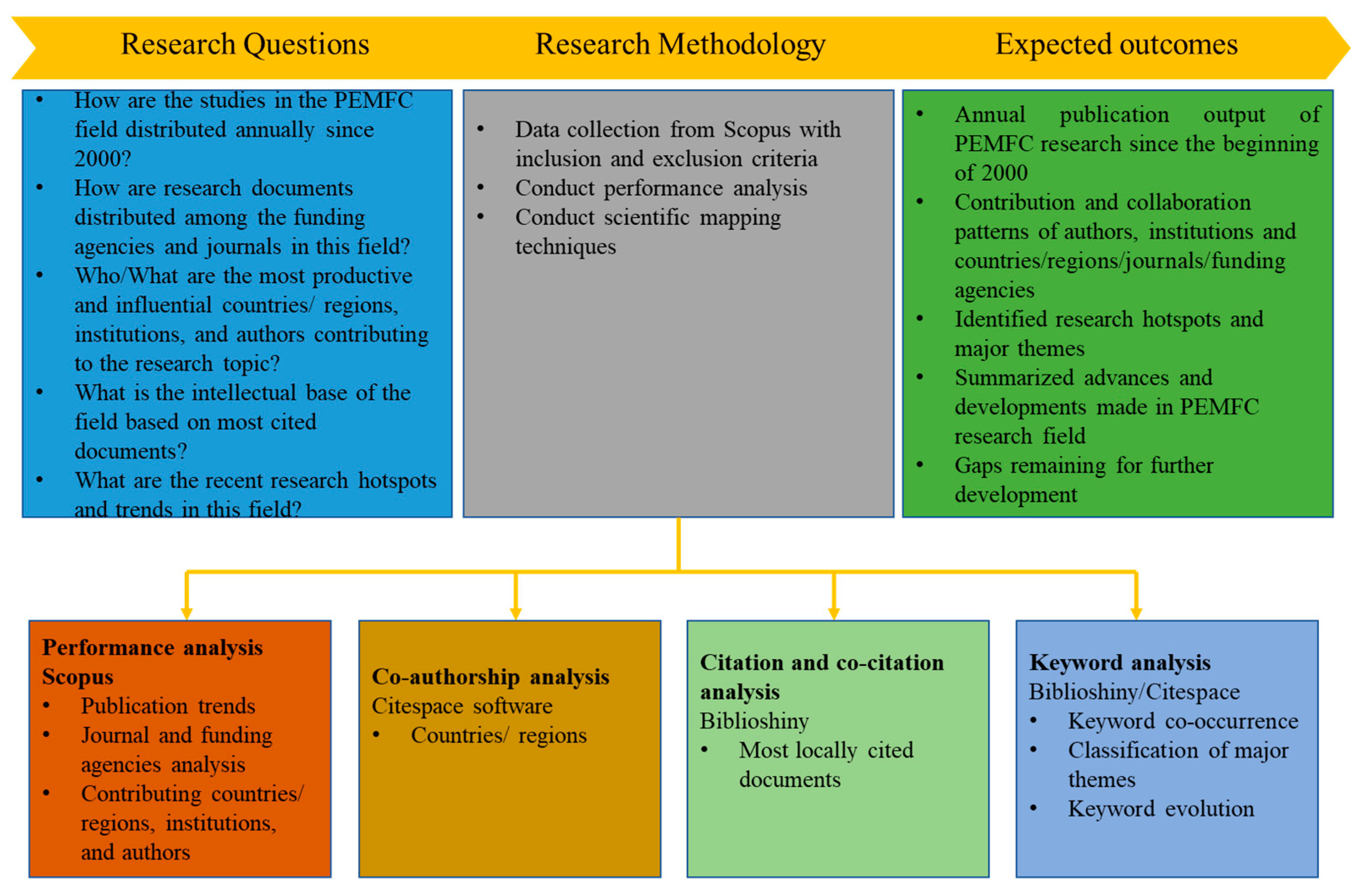
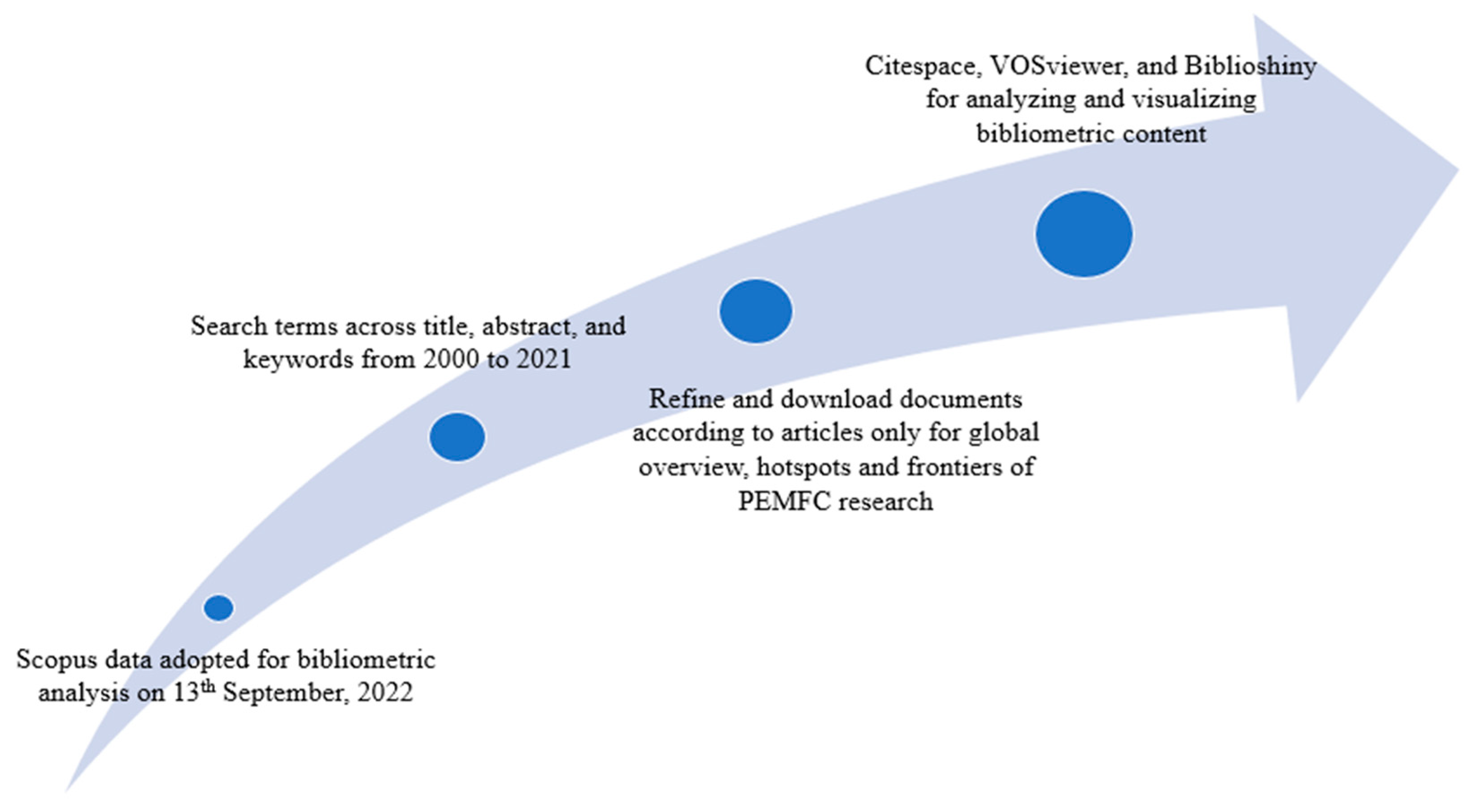
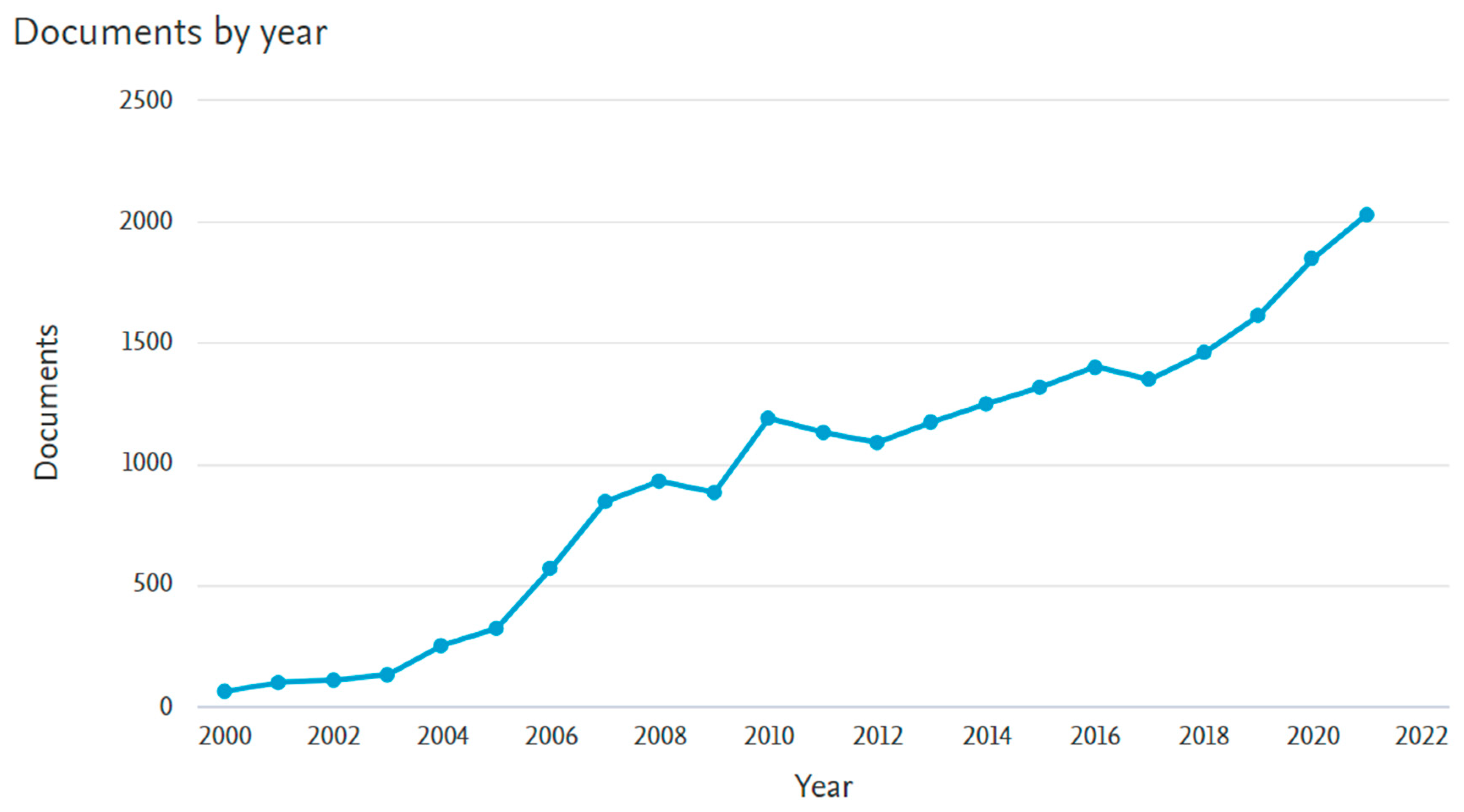
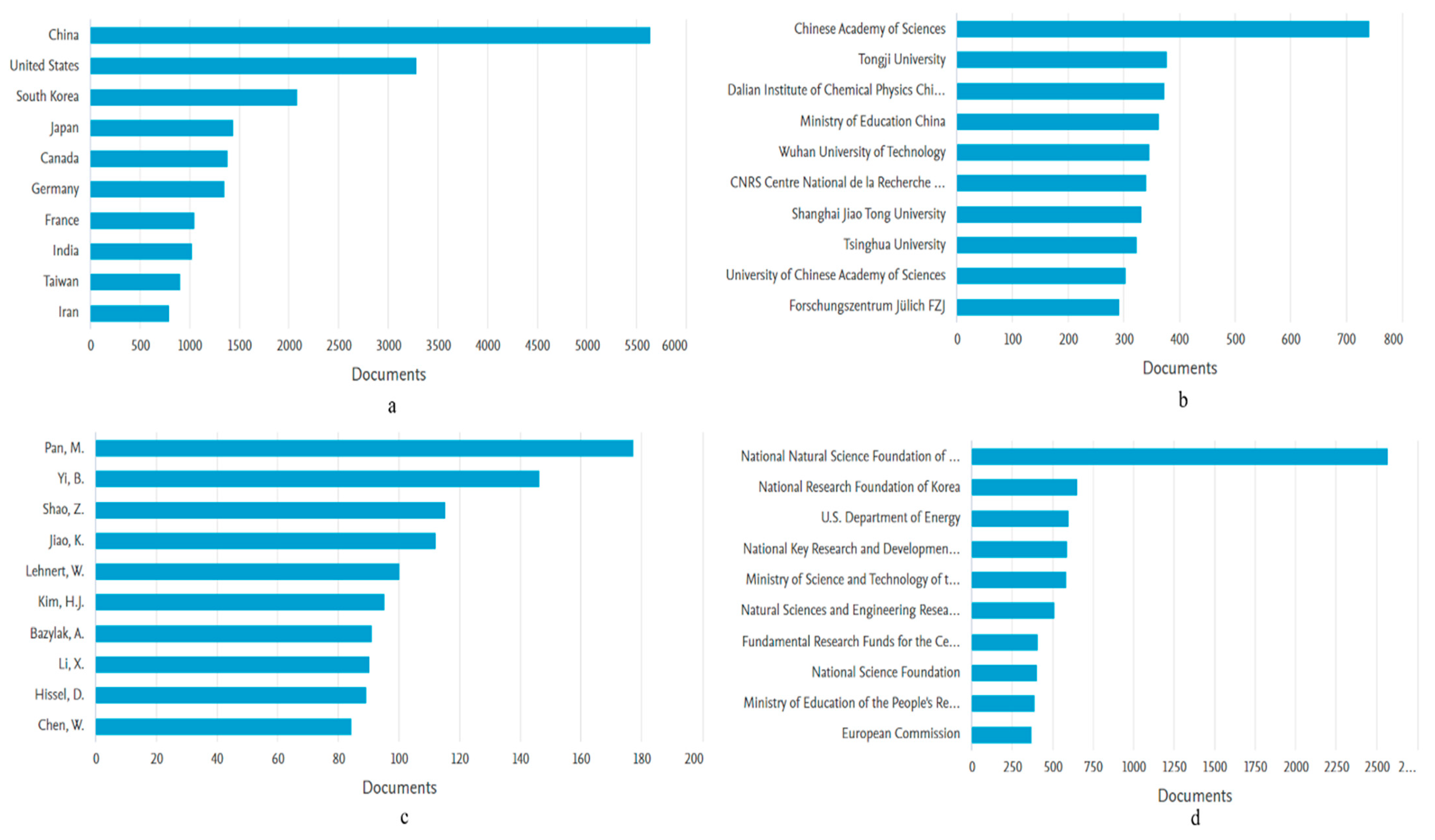
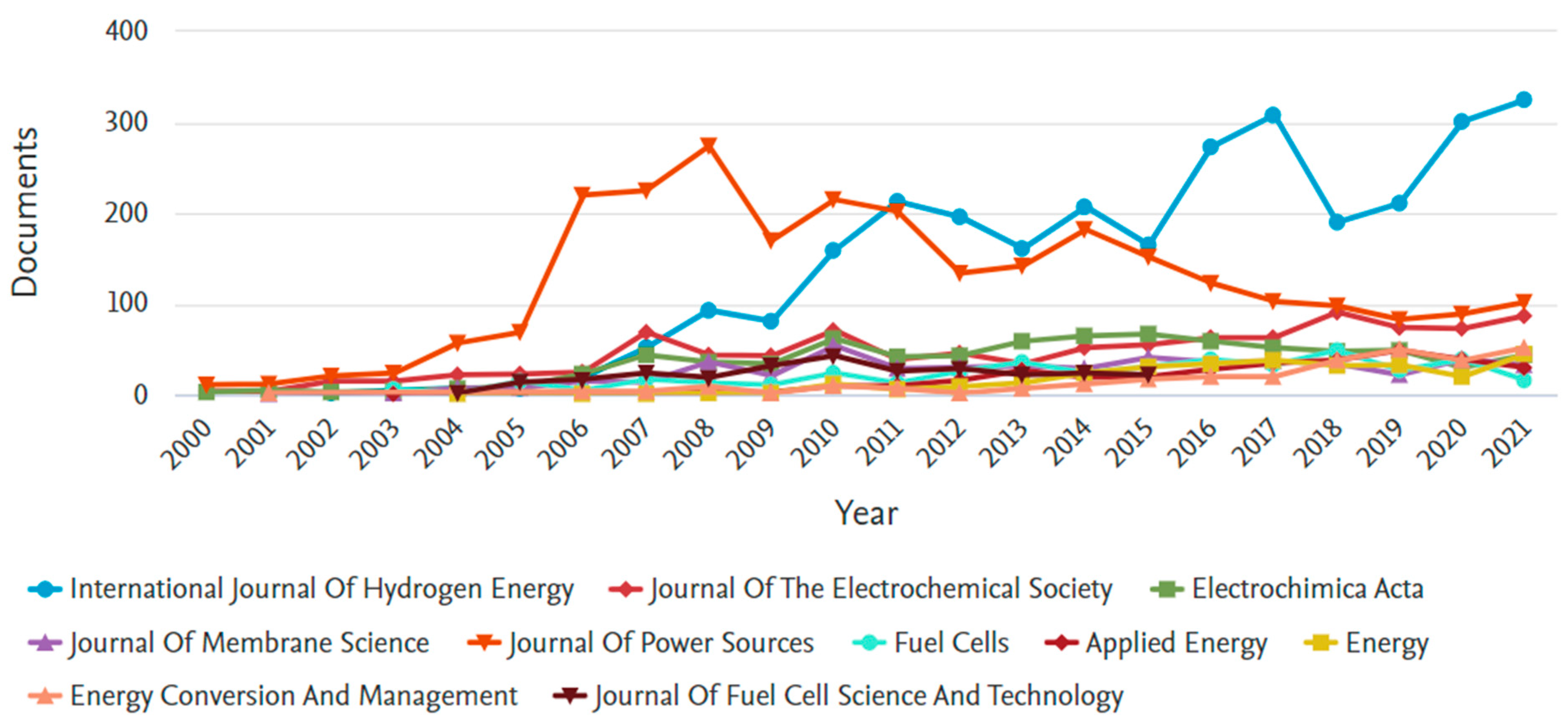

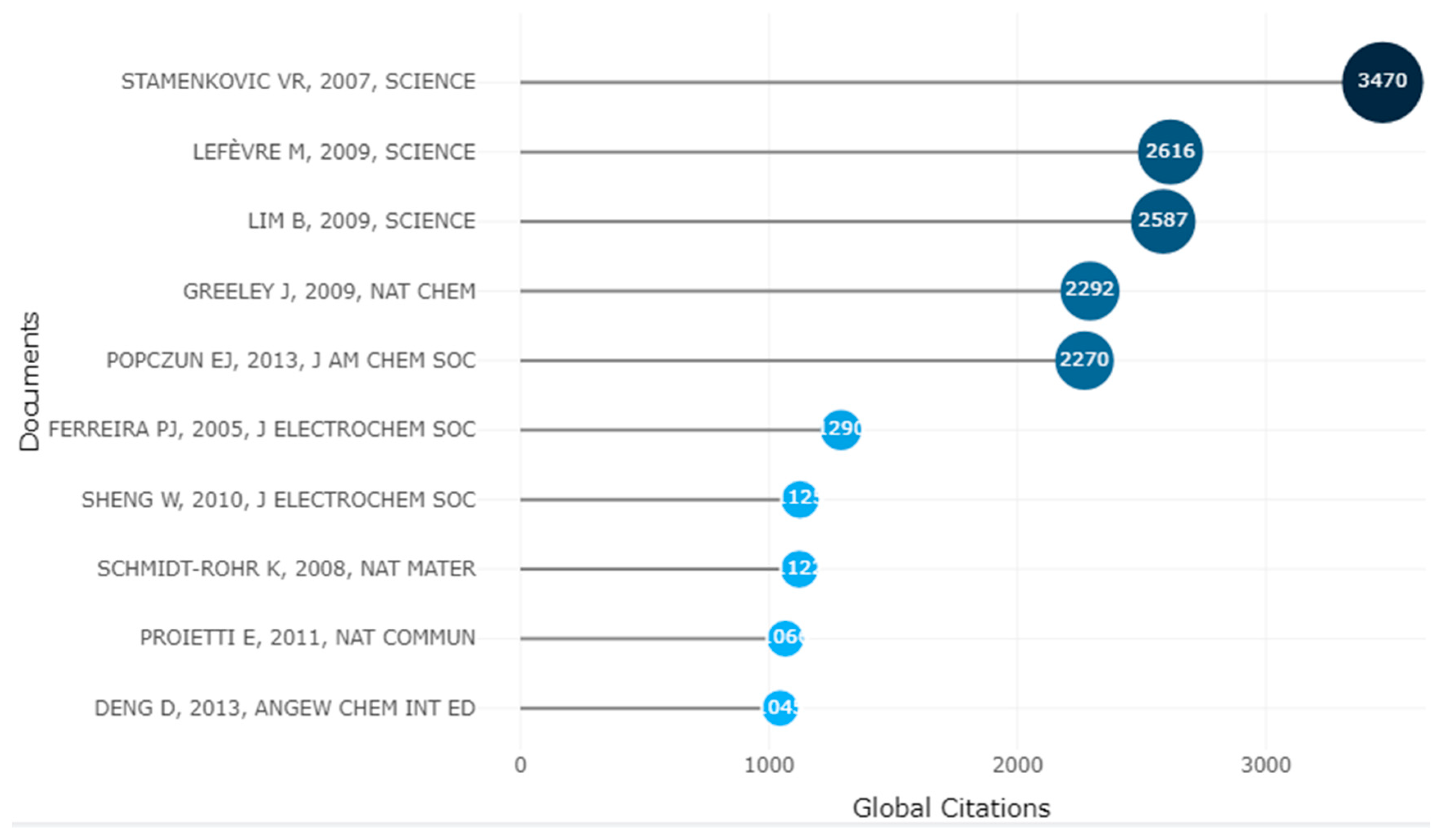
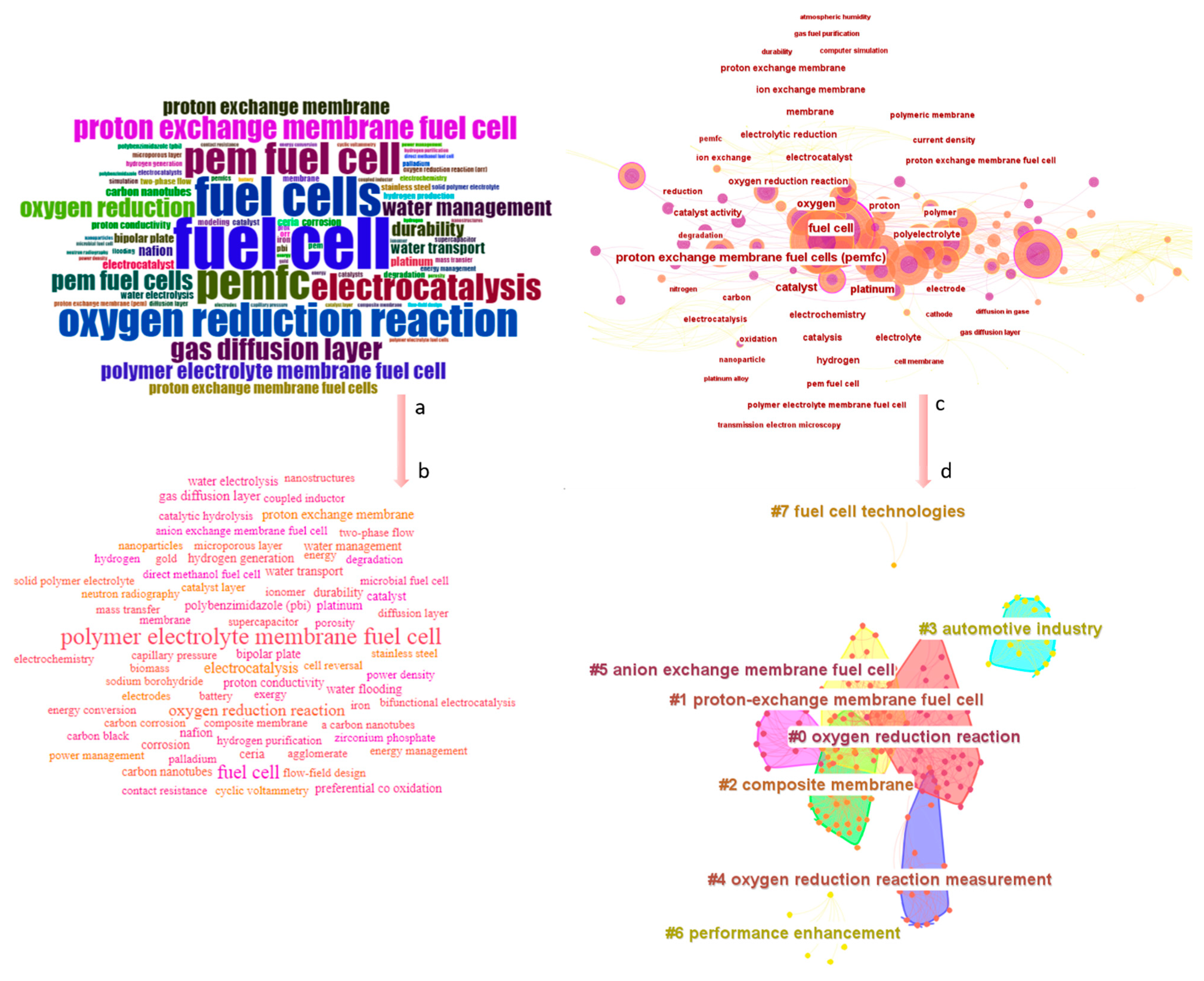
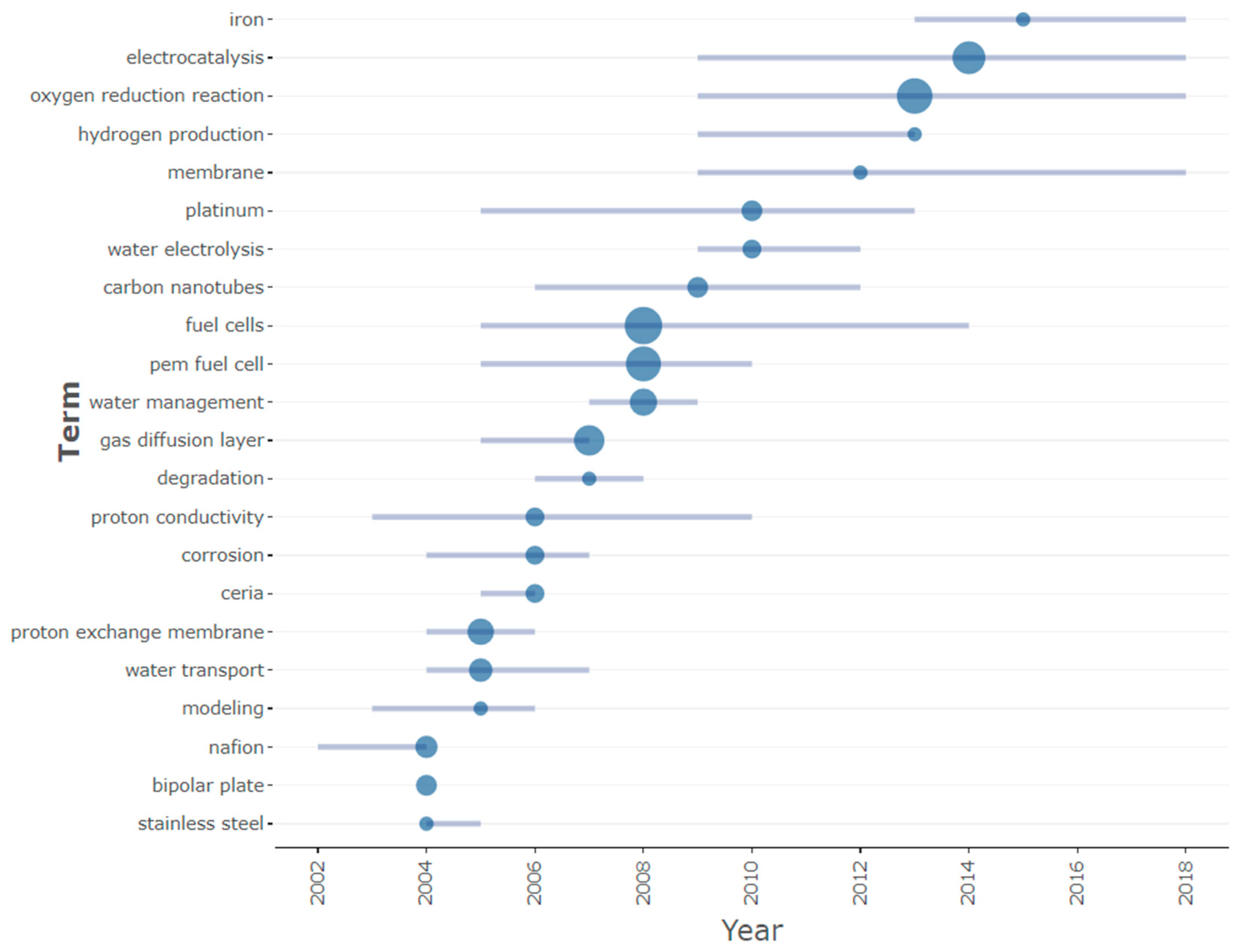
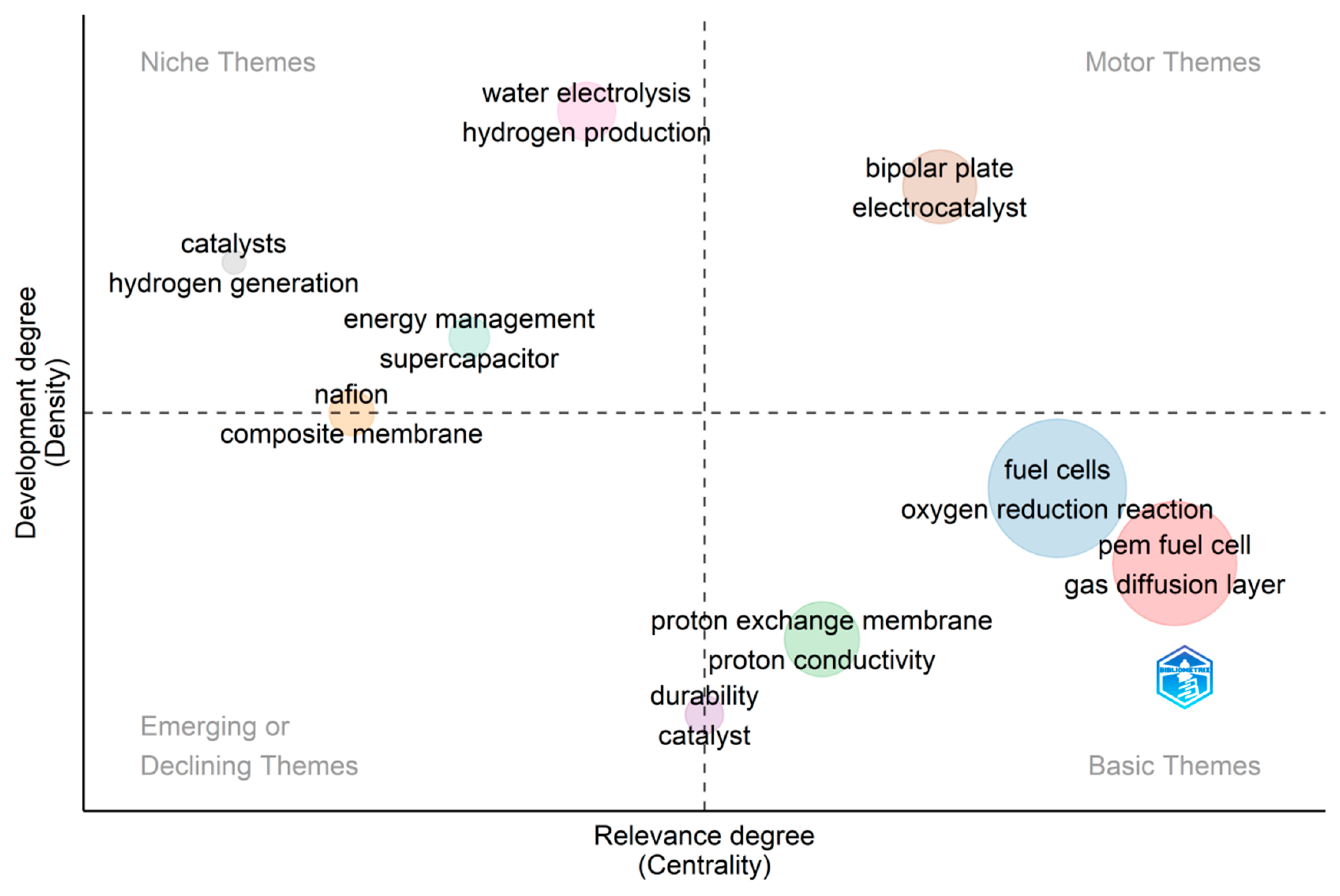
Publisher’s Note: MDPI stays neutral with regard to jurisdictional claims in published maps and institutional affiliations. |
© 2022 by the authors. Licensee MDPI, Basel, Switzerland. This article is an open access article distributed under the terms and conditions of the Creative Commons Attribution (CC BY) license (https://creativecommons.org/licenses/by/4.0/).
Share and Cite
Agyekum, E.B.; Ampah, J.D.; Wilberforce, T.; Afrane, S.; Nutakor, C. Research Progress, Trends, and Current State of Development on PEMFC-New Insights from a Bibliometric Analysis and Characteristics of Two Decades of Research Output. Membranes 2022, 12, 1103. https://doi.org/10.3390/membranes12111103
Agyekum EB, Ampah JD, Wilberforce T, Afrane S, Nutakor C. Research Progress, Trends, and Current State of Development on PEMFC-New Insights from a Bibliometric Analysis and Characteristics of Two Decades of Research Output. Membranes. 2022; 12(11):1103. https://doi.org/10.3390/membranes12111103
Chicago/Turabian StyleAgyekum, Ephraim Bonah, Jeffrey Dankwa Ampah, Tabbi Wilberforce, Sandylove Afrane, and Christabel Nutakor. 2022. "Research Progress, Trends, and Current State of Development on PEMFC-New Insights from a Bibliometric Analysis and Characteristics of Two Decades of Research Output" Membranes 12, no. 11: 1103. https://doi.org/10.3390/membranes12111103
APA StyleAgyekum, E. B., Ampah, J. D., Wilberforce, T., Afrane, S., & Nutakor, C. (2022). Research Progress, Trends, and Current State of Development on PEMFC-New Insights from a Bibliometric Analysis and Characteristics of Two Decades of Research Output. Membranes, 12(11), 1103. https://doi.org/10.3390/membranes12111103








